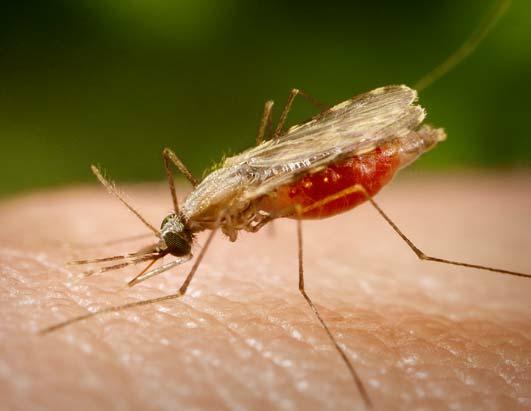Malaria case
Definition 
In the case of malaria, it is necessary to model not only the infection but also the evolution of the carrier.
In the case of malaria it is a parasite that is transmitted by mosquitoes. In the process the mosquito females transmit the parasite to the human being and vice versa the infected human being can infect the mosquito.
2.7 million people die annually from this disease.
ID:(877, 0)
Vector model simulation
Quote 
With the equation for the fraction of infected humans
| $\displaystyle\frac{di}{dt}=p_bp_I\Lambda v(1-i)-\gamma i$ |
and the fraction of infected mosquitoes is
| $\displaystyle\frac{dv}{dt}=p_bp_Vi(1-v)-\mu v$ |
You can run a simulation that shows the dynamics of both populations.
ID:(8208, 0)
Modelos con Vectores
Storyboard 
Variables
Calculations
Calculations
Equations
Examples
In the case of malaria, it is necessary to model not only the infection but also the evolution of the carrier.
In the case of malaria it is a parasite that is transmitted by mosquitoes. In the process the mosquito females transmit the parasite to the human being and vice versa the infected human being can infect the mosquito.
2.7 million people die annually from this disease.
The equation that describes the evolution of infected people
$\left(\displaystyle\frac{dI}{dt}\right)_{infectar}=p_bp_I\Lambda\displaystyle\frac{V}{N_V}(N_I-I)$
\\n\\nIn the second case it corresponds to the fraction of those who recover that behaves the same as in the 'SIR' and 'SEIR' models:\\n\\n
$\left(\displaystyle\frac{dI}{dt}\right)_{muere}=-\gamma I$
with what the equation for the infected is
The equation that describes the evolution of infected mosquitoes
$\left(\displaystyle\frac{dV}{dt}\right)_{infectar}=p_bp_V\displaystyle\frac{I}{N_I}(N_V-V)$
\\n\\nIn the second case it corresponds to the fraction of those who die that behaves the same as in the SIR and SEIR models:\\n\\n
$\left(\displaystyle\frac{dV}{dt}\right)_{muere}=-\mu V$
with what the equation for the infected is
With
In the event that the system enters a stationary phase, the temporal derivative will be in both equations equal to zero. This gives us the equations
Y
$\displaystyle\frac{dI}{dt}\displaystyle\bigg|_{I=I_{\infty}}=p_bp_I\Lambda V_{\infty}(N_I-I_{\infty})-\gamma I_{\infty}N_V=0$
\\n\\nY\\n\\n
$\displaystyle\frac{dV}{dt}\displaystyle\bigg|_{V=V_{\infty}}=p_bp_VI_{\infty}(N_V-V_{\infty})-\mu V_{\infty}N_I=0$
so the solution for the human being will be
In the event that the system enters a stationary phase, the temporal derivative will be in both equations equal to zero. This gives us the equations
Y
$\displaystyle\frac{dI}{dt}\displaystyle\bigg|_{I=I_{\infty}}=p_bp_I\Lambda V_{\infty}(N_I-I_{\infty})-\gamma I_{\infty}N_V=0$
\\n\\nY\\n\\n
$\displaystyle\frac{dV}{dt}\displaystyle\bigg|_{V=V_{\infty}}=p_bp_VI_{\infty}(N_V-V_{\infty})-\mu V_{\infty}N_I=0$
so the solution for the mosquito will be
To avoid working with very large numbers, it is convenient to transform the equations based on the fraction of human infected rather than the total number. This is why it is introduced
To avoid working with very large numbers it is convenient to transform the equations based on the fraction of infected mosquitoes instead of the total number. This is why it is introduced
With the equation the number of infected humans is
and the fraction of infected humans
and infected mosquitoes
is obtained
With the equation for the evolution of the number of infected mosquitoes it is
and the fraction of infected humans
and infected mosquitoes
it has to
Since the number of infected humans in the stationary limit is
you can with
rewrite the limit for the infected fraction
As the number of infected mosquitoes in the stationary limit is
and you have that the fraction is
a limit fraction can be estimated by
With the equation for the fraction of infected humans
and the fraction of infected mosquitoes is
You can run a simulation that shows the dynamics of both populations.
ID:(350, 0)

